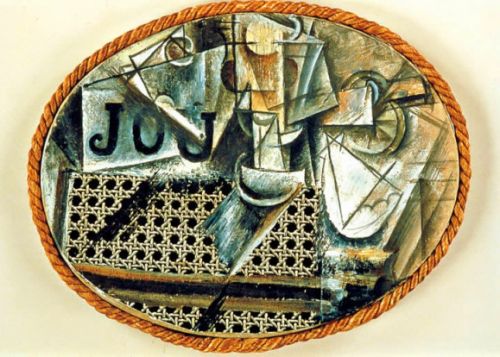Collage is the name given to a two-dimensional plastic arts technique that consists of joining, adhering or superimposing images, fragments and materials of different types and provenance on a single surface.
The word collage comes from the French coller, which means to strain, adhere or paste on a surface.
Raoul Hausmann: Elasticum. 1920. Collage.
The purpose of the technique is to seek to evoke different textures and / or figurative and conceptual associations. The collage allows the artist or craftsman to combine fragments of photographs, textiles, newspapers, magazines, paper, cardboard, cork, leather, sawdust, pencil shavings, metal, plastic, wood, etc. on the surface.
By extension, collage is called to all compositional techniques (musical, literary, cinematographic or other) that articulate or superimpose fragments of different origin in one piece.
Today there are digital applications that automate the collage process from photographs and digitized images.
Origin of the collage
Collage backgrounds date back to the Old East. It is known that Japanese calligraphers prepared surfaces with cut-outs of multicolored papers and glue to write their poems.
The collage technique was introduced to the plastic arts in the twentieth century by Cubism. In this regard, there is a dispute over who was the first of the Cubists to make it known: Braque or Picasso, as both painters applied the technique in 1912.
Picasso used rubber and other resources as a rope in his work Still Life with a grid chair. Braque used wallpaper cuttings imitating wood in his work Tête de femme.
Pablo Picasso: Still life with a grid chair. 1912. Technique: oil collage, waxed cloth, paper and rope on canvas. Measures: 27 x 35 cm.
In any case, it is known for sure that this movement implemented the technique for the first time, and its impact was so significant that from there it also passed to other trends such as Dadaism and Surrealism. His imprint was felt in the second wave of avant-garde, as in pop art, and also in the graphic design of the twentieth century.
Dadaism, from the collage technique, managed to go a step further by introducing the technique of ready made or “found object”, a technique that consisted of taking an object of daily life and intervening.
The collage has been used as an artistic technique by figures such as Juan Gris, Marcel Duchamp, Max Ernst, George Grosz, Yoly Vittorino, Arthur G. Dove, Edoardo Paolozzi, etc.
Types of collage
- Grid collage: those who build two-dimensional images that are perceived as a unified set.
- Three-dimensional collage: Refers to those that give three-dimensional pieces three-dimensionality by introducing outstanding objects on the surfaces.
- Collageof photographs: those who have photographs as predominant compositional elements.
- Mosaic collage: those whose combination of fragments is perceived as a unitary image when viewed from afar.
Difference between collage and assembly
The term collage is normally applied to two-dimensional arts, since its objective is to produce transformations on the surface other than those achieved with traditional painting.
The term assembly is specifically used to refer to sculptures that have been created by combining objects of different backgrounds. Although the principle is equivalent to collage, the term assembly is the most appropriate for these cases.



